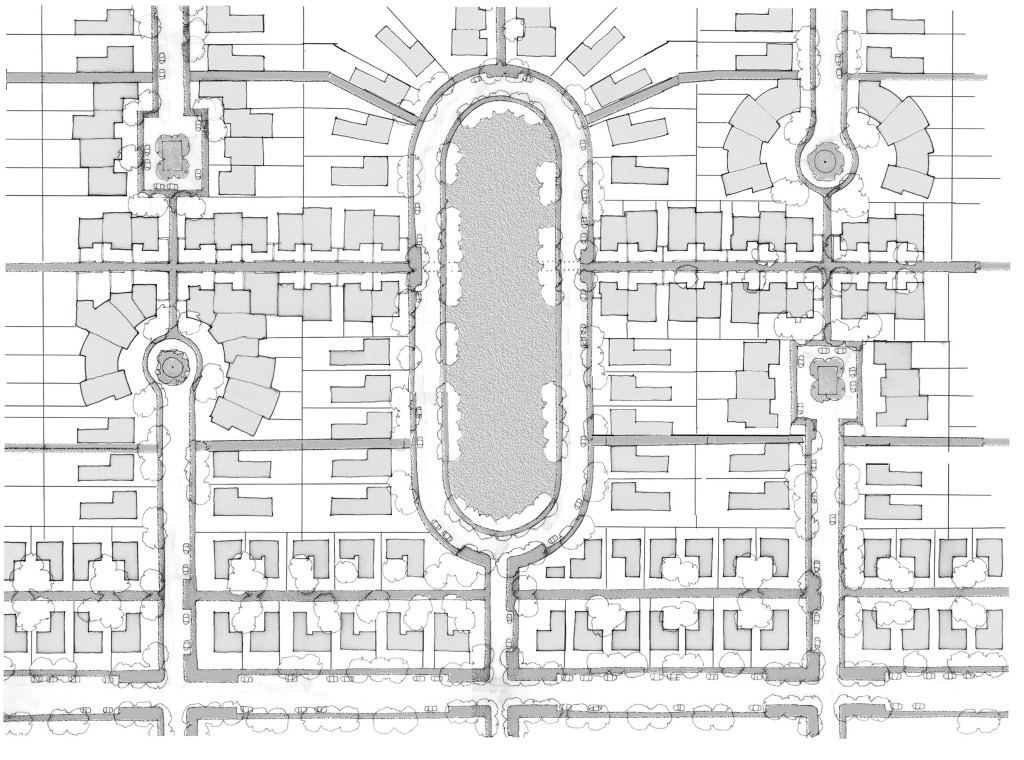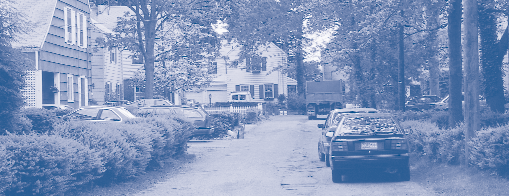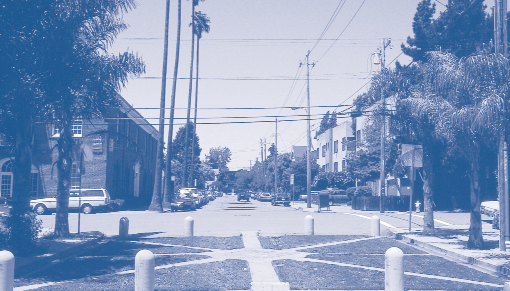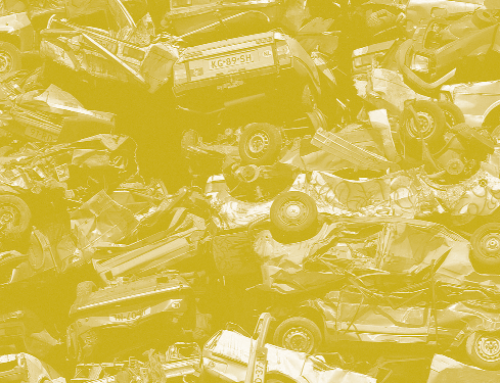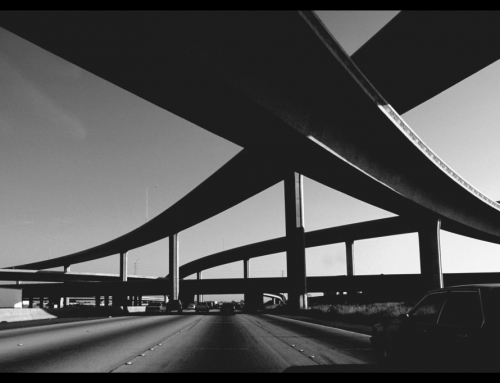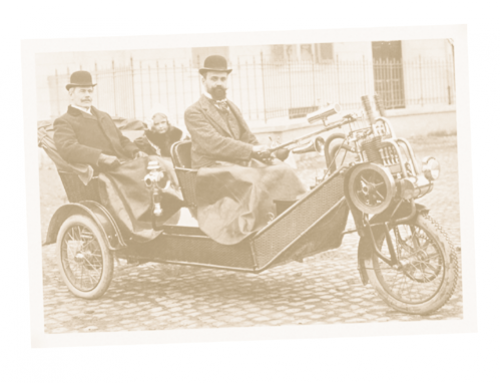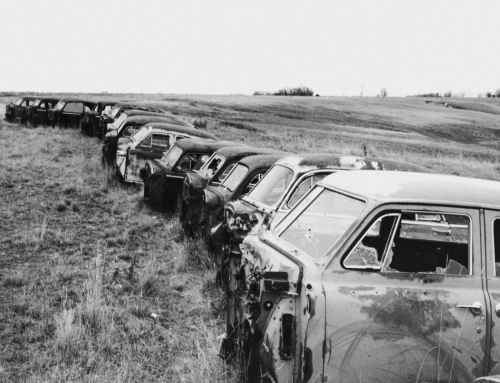[sharelines]Opening up cul-de-sacs to pedestrians and bikers could bring active travel back to the suburbs.
For over five decades developers, homebuyers, and traffic engineers have favored the cul-de-sac, a basic building block of the American suburb. Despite its popular success, the “loops and lollipops” street pattern has been repeatedly criticized by many leading architects and planners, particularly New Urbanists, who strongly advocate the inter- connected gridiron pattern. The cul-de-sac has come to symbolize all the problems of suburbia— an isolated, insular enclave, set in a formless sprawl of similar enclaves, separated socially and physically from the larger world, and dependent upon the automobile for its survival. Nevertheless, much can be said in favor of the cul-de-sac street as a pattern for neighborhood space.
The Cul-de-sac Pattern
A French term, cul de sac literally means “bottom of the sack.” It commonly refers to a dead-end street. The Oxford English Dictionary defines it as “a street, lane, or passage closed at one end, a blind alley; a place having no outlet except by the entrance.”
Since its early use in 1928 as part of the hierarchical circulation system in the design of Radburn, New Jersey, the cul-de-sac has been the preferred instrument for controlling through traffic. The town’s structure exemplified the ideal subdivision layout. As Geddes Smith stated in 1929 in Clarence Stein’s book, Toward New Towns for America, Radburn was: “A town built to live in—today and tomorrow. A town ‘for the motor age.’ A town turned outside-in—without any back doors. A town where roads and parks fit together like the fingers of your right and left hands. A town in which children need never dodge motor-trucks on their way to school.”
The first suburban cul-de-sacs were short, straight streets with just a few houses. They were intended to provide a public realm for the residents while allowing safe, slow car movement to and from dwellings. Today, with increased auto ownership, the cul-de-sac has grown wider and much longer with more dwellings along it. A circular space terminates it, large enough for service and emergency vehicles to turn around (often more than a hundred feet in diameter). In its pure form, all the houses in a subdivision are situated on cul-de-sacs, and as few as possible are placed on the busier and noisier collector streets.
A close cousin of the cul-de-sac is the loop street, which is similar in that it discourages through traffic, going nowhere other than to the homes along it. However, it has two access points, and is usually longer than the cul-de-sac. Both loops and cul-de-sacs are often found in the same development.
The cul-de-sac pattern has been strongly encouraged by traffic engineering and subdivision standards. Ever since one of the first engineering studies on residential street safety was done in Los Angeles between 1951 and 1956, the Institute of Transportation Engineers has recommended hierarchical discontinuous street systems for residential neighborhoods. The study showed that the number of accidents was substantially higher in grid-based subdivisions, so ITE established engineering standards using cul-de-sacs. The standards incorporated limited access to the perimeter highway, discontinuous local streets that discourage through traffic, curvilinear design patterns, cul-de-sacs, short streets, elbow turns, T-intersections, and a clear distinction between access streets and neighborhood collectors.
Problems with the Cul-de-sac
The loops and lollipops pattern has been criticized on several grounds. Obviously, it lacks the interconnectedness of development patterns like the gridiron. One must always leave the cul-de-sac via a collector street to go anywhere. Route choices are minimal, so one is stuck using the same path day after day. Also, since so much of the street infrastructure is devoted to semiprivate dead-end roads, a heavy load of connecting and through traffic is forced onto a relatively small collector and arterial system, contributing to suburban gridlock during peak periods of travel.
The cul-de-sac has come to symbolize all the problems of suburbia—separated from the larger world, dependent on the automobile
For the pedestrian, walks can be long and boring, with inefficient connections to nearby destinations. One lacks the sense of being in a neighborhood or town with a civic identity. Main streets and tree-lined corridors that connect places and communicate the character and structure of a community are absent, and what’s left is a string of dead-ends on faceless connectors that lead nowhere. The pattern as it has evolved is difficult for a visitor to comprehend because there is little apparent structure, no unifying elements, no clear describable pattern. Moreover, it is usually tiresome in its repetitiveness. Grid pattern developments, of course, can suffer from monotony as well, but they are easier to visualize and navigate because they form a clear, logical pattern.
Some Advantages
The cul-de-sac model has several advantages that are worth considering. From the perspective of residents, the pattern usually offers quiet, safe streets where children can play with little fear of fast-moving traffic. A discontinuous short-street system, unlike the grid, may promote 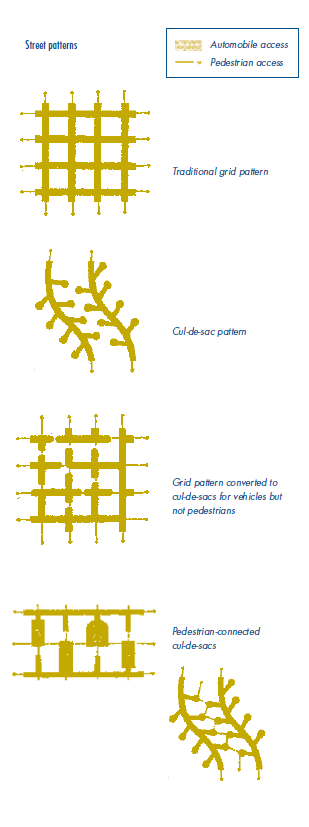 familiarity and neighboring. The cul-de-sac street pattern is also supported by the market: home buyers often pay premium prices for the most isolated cul-de-sac lots. The pattern is popular with developers not only because it sells well, but also because the infrastructure costs are significantly lower than for the traditional interconnected grid pattern, which can require up to fifty percent more road construction. Cul-de-sacs, being disconnected, adapt better to topography. Since they carry no through traffic, they often have reduced standards for street widths, sidewalks and curbs. In Radburn, for example, the introduction of cul-de-sacs reduced street area and the length of utilities, such as water and sewer lines, by 25 percent as compared to a typical gridiron street plan. According to Stein, the cost savings on roads and utilities paid for the construction of open spaces and parks.
familiarity and neighboring. The cul-de-sac street pattern is also supported by the market: home buyers often pay premium prices for the most isolated cul-de-sac lots. The pattern is popular with developers not only because it sells well, but also because the infrastructure costs are significantly lower than for the traditional interconnected grid pattern, which can require up to fifty percent more road construction. Cul-de-sacs, being disconnected, adapt better to topography. Since they carry no through traffic, they often have reduced standards for street widths, sidewalks and curbs. In Radburn, for example, the introduction of cul-de-sacs reduced street area and the length of utilities, such as water and sewer lines, by 25 percent as compared to a typical gridiron street plan. According to Stein, the cost savings on roads and utilities paid for the construction of open spaces and parks.
The pattern is not limited to low-density suburban development, but can support row houses and low-rise apartments as well. Radburn and London’s Hampstead Garden Suburb, for example, have relatively high densities by American standards (9.4 and 8 to 12 dwelling units per acre, respectively). Even higher densities can be found in historic urban patterns such as the residential courts of Boston’s Beacon Hill.
At sites of sensitive ecological character, the cul-de-sac pattern has distinct values. Unlike the grid pattern which can be very invasive, blanketing a neighborhood with infrastructure, the cul-de-sac pattern can work around areas of high ecological or historical value. Lawrence Halprin’s 1964 plan for The Sea Ranch on California’s North Coast employed a disconnected pattern of “reaches” and “closes” to keep vehicular traffic away from the ocean bluffs and to protect the meadows of the original sheep ranch. The site design for Village Homes in Davis, California, utilizes the pattern to protect a natural drainage system that serves as a community green space and pedestrian/bicycle connector. A more recent plan for Mayo Woodlands in Rochester, Minnesota, uses a similar pattern to preserve the meadows and woodlands of the former Mayo estate while allowing residential development.
Analysis of automobile accident data supports the notion that cul-de-sac and loop patterns are safer than other kinds of streets. Furthermore, hierarchical, discontinuous street systems have lower burglary rates than easily traveled street layouts; criminals will avoid street patterns where they might get trapped. For example, the troubled Five Oaks district of Dayton, Ohio, was restructured to create several small neighborhoods by converting many local streets to cul-de-sacs by means of barriers. Within a short time traffic declined 67 percent and traffic accidents fell 40 percent. Overall crime decreased 26 percent, and violent crime fell by half. At the same time, home sales and values increased.
A comparative study of street patterns indicates significant homebuyer preference for the cul-de-sac and loop patterns. We examined nine California neighborhoods in terms of safety performance and residents’ perception of their street’s livability. The neighborhoods were matched demographically but represented three different street layouts—grid, loop, and cul-de-sac. The findings suggest that cul-de-sac streets, and especially the lots at the end, perform better than grid or loop patterns in terms of traffic safety, privacy, and safety for play.
Residents also preferred the cul-de-sac as a place to live, even if they actually lived on a through or loop street. People said they felt cul-de-sac streets were safer and quieter because there was no through traffic and what traffic there was moved slowly. They also felt they were more likely to know their neighbors. One resident’s comment was typical: “Our pets and kids are safer when there is a no-outlet street; you feel kidnapping is less likely—there is more of a sense of neighborhood.” Thus, the study generally corroborated earlier transportation research on the values of a hierarchical discontinuous street pattern. It also supported claims that cul-de-sacs are more frequently and more safely used by children.
However, residents thought neighborhoods composed mainly of cul-de-sacs were confusing and lacked a coherent structure and uniqueness. Social interaction and neighborhood sense were not necessarily stronger on the cul-de-sacs, despite perceptions to the contrary. At the neighborhood scale, problems associated with cul-de-sacs may stem more from land use patterns than the street pattern itself. The single-use zoning of most cul-de-sac neighborhoods puts schools, jobs, and recreation and commercial centers at a distance from homes. Separation is further exacerbated by the lack of a well-connected pedestrian/bicycle network. Only rarely is there an interconnected pedestrian pathway system linking cul-de-sacs with adjacent streets, open spaces, and other neighborhoods.
Creative Cul-de-sacs
The cul-de-sac pattern presents a dilemma for the designer committed to a more structured and conceptually clear design like the geometric grid. Might it be possible to satisfy both sets of criteria: privacy, safety, quiet, and lower construction costs, as well as connectedness, identity, and structure? The cul-de-sac certainly need not be an undefined street terminated by an amorphous blob. The benefits of the cul-de-sac could be achieved with more architecturally defined and ordered patterns. A review of historic urban patterns in Europe, the Middle East, and early American towns reveals a frequent use of such patterns. For example, courts, closes, and quadrangles are found in English, French, and German towns of the Middle Ages. The residential court is also found in many early American towns, from Philadelphia to Boston. Today such spaces are usually prized locations for their sense of privacy, their intimate scale, and their charm.
A century ago, Raymond Unwin and Barry Parker consciously emulated such patterns in their designs for Hampstead Garden Suburb in London. “For residential purposes, particularly since the development of the motor-car, the cul-de-sac roads, far from being undesirable, are especially to be desired for those who like quiet for their dwellings,” declared Unwin. An act of Parliament was required to allow the use of cul-de-sacs in new development, since prior cul-de-sacs were associated with unplanned medieval cities and unhealthful living conditions. It was the first time a planned development systematically used the cul-de-sac and open court throughout.
People felt cul-de-sac streets were safer and quieter, and they were more likely to know their neighbors.
In Hampstead’s court and close arrangements, two- to three-story blocks of row houses or apartments border a central green space and are usually accessed by a narrow service road. This arrangement creates a relatively quiet, pedestrian-oriented environment removed from the public street. The cul- de-sacs achieve similar residential neighborhood values. Unlike amorphous American postwar cul-de-sacs, those in Hampstead are short and narrow, with no circular turn-around at the end, and the architecture defines the street space. Midblock pedestrian walks typically connect the end of the cul-de-sac to another street or cul-de-sac beyond, creating an engaging path network for pedestrians. Roads are designed to discourage through traffic; they vary in both layout and cross-section design according to function. Sidewalks are always present. Trees and shrubs, as well as architectural details such as walls, fences, and gates, make each street a unique pedestrian throughway. Hampstead Garden Suburb became an influential prototype for residential subdivision street design and road planning in Britain and North America. Sadly, however, the urban design qualities of the original have been lost in its offspring.
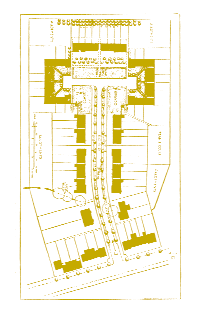 An ideal suburban residential environment might be based on similar courts and closes, each a defined space with its own special character, with limited automobile access, situated within an overall structure of treed boulevards and public spaces that create a sense of community. Automobile movement would be limited to collector and arterial streets, but pedestrians and bicyclists could enjoy the easy interconnectedness of a classic gridiron. The pedestrian network can parallel the vehicular routes, but can also connect cul-de-sacs and loops with each other, as well as with destinations such as parks, schools, and shops. A hammerhead or formal square configuration eliminates irregularly shaped lots and creates a well-defined relationship between buildings, street, and the open space at the end of the street.
An ideal suburban residential environment might be based on similar courts and closes, each a defined space with its own special character, with limited automobile access, situated within an overall structure of treed boulevards and public spaces that create a sense of community. Automobile movement would be limited to collector and arterial streets, but pedestrians and bicyclists could enjoy the easy interconnectedness of a classic gridiron. The pedestrian network can parallel the vehicular routes, but can also connect cul-de-sacs and loops with each other, as well as with destinations such as parks, schools, and shops. A hammerhead or formal square configuration eliminates irregularly shaped lots and creates a well-defined relationship between buildings, street, and the open space at the end of the street.
The scheme used in Radburn, designed by Clarence Stein and Henry Wright, is a variant of this ideal. Houses are clustered around automobile-accessible cul-de-sacs. The pedestrian path system expands into greenways and parks, with paths connecting each home, as well as the school. Pedestrians can go almost anywhere with minimal interference from the automobile. Although the open spaces of Radburn are rather lavish, the same values could be achieved with much less open space if builders focused primarily on the pedestrian pathway system.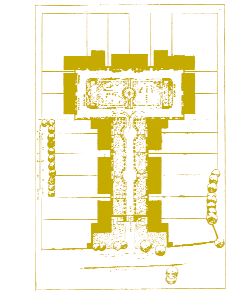
Today there is a surge of interest in traffic-calming measures across the country, and many communities are taking steps to make streets more pedestrian- and bicycle-friendly. Some traditional neighborhoods based on the grid pattern found in most older American towns and cities built before the 1920s are being retrofit to achieve some of the values of the cul-de-sac. These neighborhoods possess the connectedness, structure, walkability, and accessible land use patterns that many planners seek today in new residential developments. They are, however, subject to invasion by the automobile and often suffer from the noise and hazards that come with excessive traffic on local residential streets. Berkeley, California, is one community that has attempted to deal with the problem. Its grid system has been converted into cul-de-sacs and loops by placing bollards, large concrete planters, or planted islands as traffic barriers across some intersections. Pedestrians and bicyclists can easily get through and continue to enjoy the interconnected grid. Originally an experiment, the scheme was strongly advocated by residents of some neighborhoods, although disliked by others. Nevertheless, support was broad enough to make it a permanent program.
Retrofitting an existing suburban cul-de-sac development to provide pedestrian connectedness would be more difficult. New pathways could be designed to interconnect cul-de-sacs, but in most cases they would have to be built on private rights-of-way along lot lines. To acquire such easements would probably be difficult, since residents are unlikely to give up a portion of their land and privacy. Moreover, most suburban developments of this type are single-use subdivisions so there is very little to connect besides houses.
Are walkable suburbs possible today? It is necessary to challenge the established street design standards and regulations that have emphasized vehicular access at the expense of pedestrian connectedness and community form. Traffic engineers and public officials need to review existing standards and establish new frameworks that support the pedestrian and bicyclist while taming and confining the automobile. However, rather than tossing out the cul-de-sac as an urban pattern, it is worth reconsidering its values and possibilities in creative ways. It has a long history of use in a variety of geographic and cultural contexts, and could provide options that offer safe and quiet streets as well as pedestrian and bicycle access in a new spatial framework that avoids the problems of the open grid.
Further Readings
Eran Ben-Joseph, Livability and Safety of Suburban Street Patterns: A Comparative Study (Berkeley, CA: Institute of Urban and Regional Development, University of California, Working Paper 641, 1995).
Oscar Newman, “Defensible Space—A New Physical Planning Tool for Urban Revitalization,” Journal of the American Planning Association, vol. 61, no. 2, Spring 1995, pages 149–155.
Michael Southworth and Eran Ben-Joseph. Streets and the Shaping of Towns and Cities (Washington, DC: Island Press, 2003).

